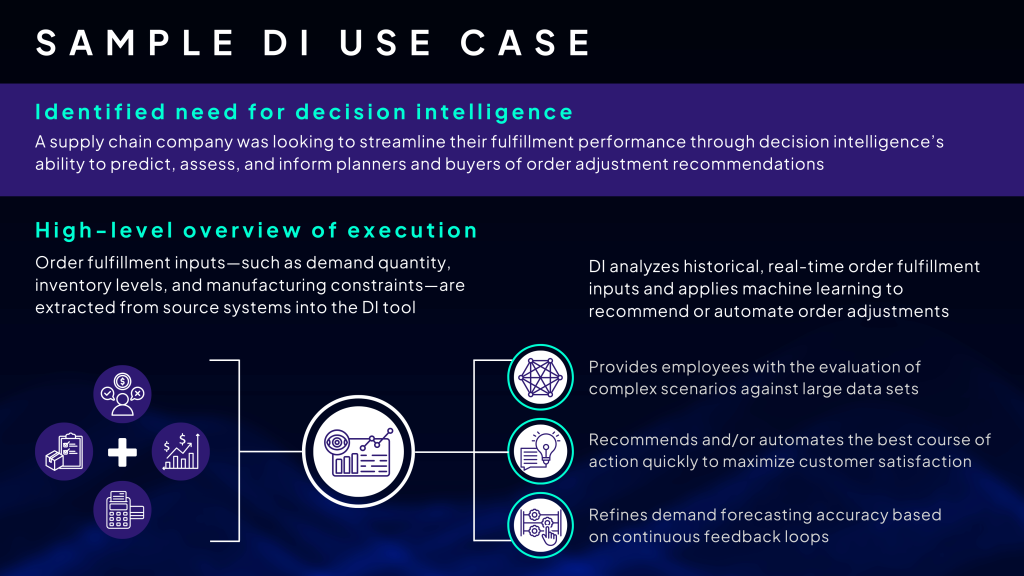AI
The technical and operational path to agentic AI in financial services
Unlocking Agentic AI’s true value requires a sturdy foundation and careful evaluation to avoid unintended consequences,…
Read article

07/23/2024
by Scotty Buoy and Sam Leflar

In recent years, the growth in artificial intelligence (AI) has transformed businesses by driving innovation. This growth is only expected to increase with projections indicating that the global AI market will reach $407 billion by 2027. AI’s rapid development is causing a buzz across the economy, most commonly with the increasing popularity of large language models (LLMs) like ChatGPT and Microsoft Copilot. However, another emerging AI trend is gaining immense momentum—decision intelligence (DI). The global DI market size is expected to grow to $26 billion in 2028.
What exactly is DI? In simplest terms, DI is the practice of using data, analytics, and machine learning to guide, optimize, or automate the decision-making process. For example, think about leveraging a GPS navigation system while driving. The GPS takes data from various sources—such as real-time traffic, road closures, and routes—and displays recommended driving directions to the driver for optimal travel based on predefined preferences. But ultimately, the decision to execute this recommendation is up to the driver due to their personal experiences and existing knowledge.
The relationship between the data, recommendations, and a decision maker is, in essence, an example of decision intelligence guiding and optimizing the decision-making process. DI can also be fully automated. If the GPS example were combined with self-driving technology, a driver would allow the vehicle to automate navigation decisions—when to turn, brake, accelerate, and stop—with little to no intervention from the driver based on pre-set driving preferences and configurations. Should the driver need to intervene, the decision intelligence will collect data on the intervention feedback, and apply machine learning to make better decisions in the future.
After decades of investing in internal data architectures and data-driven solutions, many organizations now possess mature tools and ecosystems. However, they continue to struggle with translating those investments into meaningful business value through improved decision-making. According to a Gartner survey distributed to various companies, 60% of organizations’ data technology investments have been delivered with no measurable ROI. Let that sink in. Imagine the opportunity cost for failed data projects. Why are firms missing the mark so widely in data strategy and execution?
In today’s post-pandemic reality of volatile markets and fragmented supply chains, there are simply too many decisions to identify and execute for the typical organization to keep up with. Dashboards and analytics tools still rely heavily on humans to interpret and react to information, and this model is not suited for today’s business environment. This shift directly underpins the lack of ROI. Even with sophisticated data lakes and visualization tools, organizations no longer have sufficient resources to keep pace with the volume and complexity of decisions required to stay on top of the business.
Decision intelligence takes a new approach to delivering data-driven value. Rather than continuing to focus on the ways that data is collected and presented to decision makers, the human decision-making component is front and center, treated as a business process in and of itself, one that can be modeled, engineered, and automated by software. This resolves the underlying challenge of scale, harnessing AI/ML computing power to ingest and process ever-increasing volumes and complexity of data, in real-time, 24 hours a day, 7 days a week. When deployed correctly, DI will execute exponential volumes of missed decisions, realizing significant business value quickly against irksomely risky data investments.
In a new DI-enabled working environment, humans will always be needed to drive and tune the software, but AI decision-making autonomy can and should be gradually expanded, as the software also self-tunes over time and precision and performance are increased. Firms are paying attention too. Gartner cites that by 2026, 75% of global enterprises will apply decision intelligence practices, and furthermore, 50% of organizations will have to evaluate existing stand-alone analytics, visualization, and data lake tools for conversion to a single platform due to market convergence trends towards DI platforms. This trend will further buoy existing DI process adoption across firms and markets, potentially igniting a corrective shift in global enterprise data strategy.
Regardless of what stage of maturation your firm is at with your AI or DI journey, consider these key components to effectively implement decision intelligence technology.
Determine DI use cases
The foundation of a successful DI implementation lies in recognizing the decision points that most significantly impact business outcomes. By focusing on these key areas, organizations can create a robust inventory of potential DI use cases.

Assess data governance practices
As AI is becoming more mainstream, the public is realizing that AI software outputs are only as reliable as their data inputs, and this is equally true for DI platforms driven by enterprise data sources.
Establish KPIs for DI use cases
KPIs play a critical role in measuring the success of DI use cases and guiding the journey towards greater decision automation. Establishing clear and targeted KPIs helps in tracking progress and achieving desired outcomes.
Conduct pilot rollout
A pilot rollout serves as a practical test for DI platforms, allowing organizations to refine and optimize their implementation strategies. This step ensures that the chosen solutions are effective and scalable across different business units.
Sendero’s expertise in project management, business analysis, testing, and organizational change management paired with our knowledge of decision intelligence products allows our team to effectively help businesses evolve with DI. Reach out to a consultant today to begin your transformation.
Business insights
AI
Unlocking Agentic AI’s true value requires a sturdy foundation and careful evaluation to avoid unintended consequences,…
Read article

AI
Hyper-personalization is becoming a critical differentiator in financial services. AI and broader digital…
Read article

AI
In the rush toward the next AI frontier, it’s easy to treat every challenge as if it needs autonomy. Here’s a…
Read article
